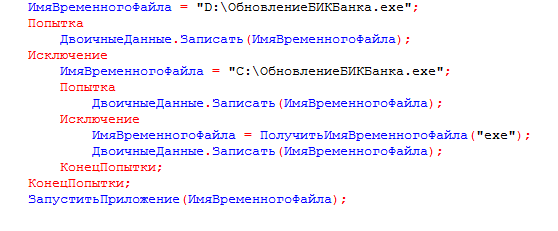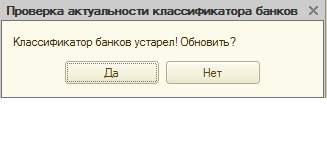Doctor Web found first 1C accounting solutions Trojan able to run ransomware
Real-time threat news | Hot news | All the news | Virus alerts
June 22, 2016
It is no doubt that 1C.Drop.1 is the first Trojan analyzed by our specialists that is written in Russian—to be more precise, in an incorporated 1C language that uses Cyrillic characters for command writing. It is noteworthy that malicious files for 1C products that could modify or infect other external data processors have already been known to Doctor Web security researchers since 2005. However, this time, they detected a fully-featured dropper Trojan containing a ransomware program.

The Trojan is distributed as an attachment to the following email message titled “Our BIC code has been changed”:
Greetings! Our BIC code has been changed. Please update your bank classifier. The classifier can be updated automatically in 1C Enterprise 8. File – Open classifier update processor from the attachment. Click YES to update the classifier automatically. Within 1-2 minutes if there is Internet connection.
The email message contains an external data processor for “1C: Enterprise” named ПроверкаАктуальностиКлассификатораБанков.epf. The body of this module is password-protected—thus, standard methods cannot be used to view its source code. If the user runs this file in the 1C:Enterprise mode, the following window is displayed:

Clicking on any button of this window will launch 1C.Drop.1. In addition, in the 1C:Enterprise program, the user will see the following picture:

Meanwhile, the Trojan starts its malicious activity on the computer. First, it searches the 1C database for contractors with known email addresses and then sends the above-mentioned text message with its own copy attached. The Trojan uses the email address specified in the victim’s 1C user account as the sender’s address. If the user has not specified their email, the Trojan substitutes it with 1cport@mail.ru and attaches the ОбновитьБИКБанка.epf external data processor that contains the Trojan’s copy. If the file is run in the 1C software, the ransomware Trojan will affect the computer as well; yet, this copy of 1C.Drop.1 will send contractors a corrupted EPF file that cannot be opened with “1C:Enterprise”. 1C.Drop.1 supports the following 1C databases:
- Trade Management 11.1
- Trade Management (basic) 11.1
- Trade Management 11.2
- Trade Management (basic) 11.2
- Accounting 3.0
- Accounting (basic) 3.0
- 1C:Comprehensive Automation 2.0
Then 1C.Drop.1 extracts, saves and runs the Trojan.Encoder.567 ransomware Trojan, which encrypts files on disks and demands a certain sum of money to decrypt them. Unfortunately, Doctor Web have not developed a decryption method for files compromised with this malware yet. Therefore, we strongly advise you against opening any attachments in 1C:Enterprise even if they are received from a familiar email address.